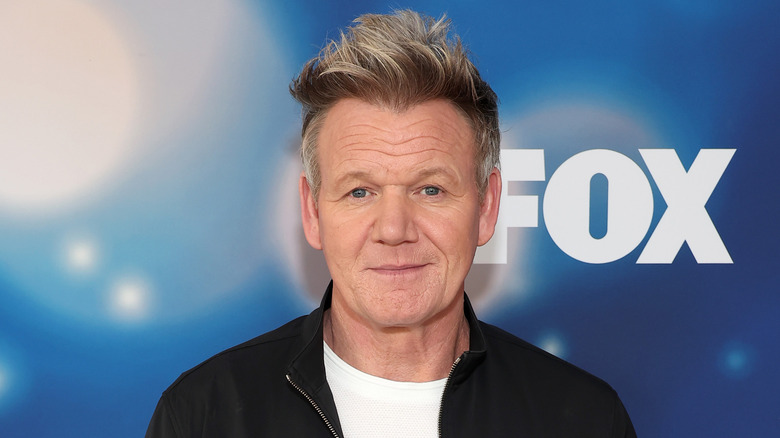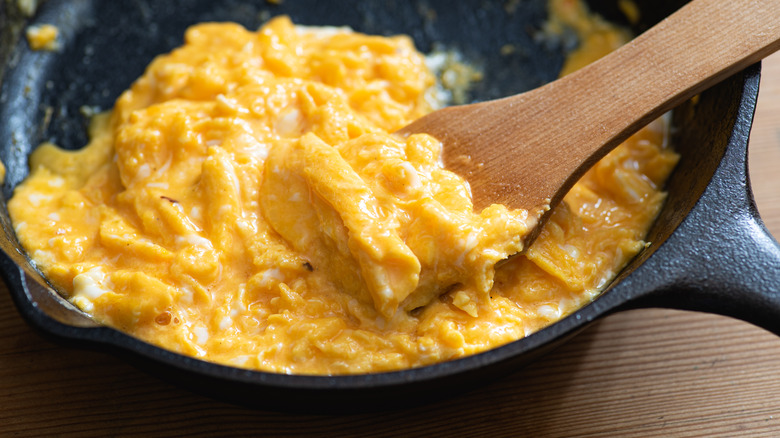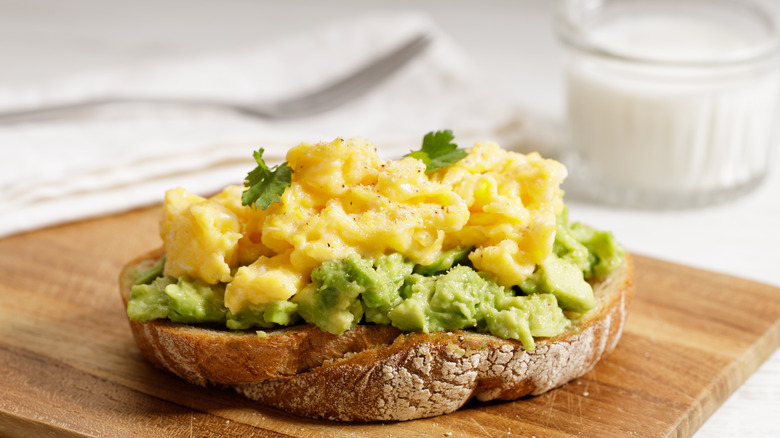Gordon Ramsay Never Whisks His Scrambled Eggs
Scrambled eggs may seem like a simple dish, but many chefs have very different approaches to the breakfast and brunch favorite. Julia Child's raw egg trick for creamier scrambles involves salting and whisking the eggs before cooking them in stages. Ina Garten's French method for velvety scrambled eggs centers around whisking the eggs with half-and-half before cooking them over low heat. But British chef Gordon Ramsay has a completely contrasting technique: He doesn't whisk the eggs at all.
The chef and TV personality believes that whisking eggs before they are cooked gives them an unpleasantly grainy texture. Instead, he simply breaks cold whole eggs directly into a pan, adds butter for richness, and folds them with a spatula as they cook.
As well as being a technique that promises light and fluffy eggs, chef Ramsay's approach also means a faster breakfast since it removes the process of breaking the eggs into a separate bowl and whisking them before they hit the pan. And as a result, the streamlined technique also requires less washing up when you're finished, which is certainly something that will appeal to many busy home cooks.
Gordon Ramsay uses a spatula and high heat for fluffy eggs
It's a commonly-held belief that eggs should be whisked immediately before they are scrambled, as this process adds air into the mixture for a fluffier result. But rather than using a whisk, Gordon Ramsay uses a rubber spatula to break down the cracked whole eggs as soon as they're in the pan. He then uses the utensil to pull the eggs down from the side of the pan into the center as they cook, so there's no waste, folding them rather than whisking, and stirring constantly.
Many chefs favor a low-and-slow approach to scrambling eggs for a softer consistency with smaller curds, which can take a long time. But chef Ramsay achieves a similarly fluffy texture faster by starting the cooking process over a high heat, and repeatedly moving the pan on and off the burner as the curds start to thicken, so they don't overcook.
Using a deep pan, Ramsay's process involves 30 seconds on the heat, followed by 10 seconds off the heat, for a total of around three minutes; though when using a non-stick pan, the chef scrambles for a minute on high heat followed by 30 seconds off, before turning the temperature down. Whichever temperature and timings you prefer, when scrambling eggs, it's important to take them off the heat just before they're ready, as the residual heat from the pan carries on cooking them to your desired consistency.
How salt and liquid affect the texture of scrambled eggs
When to season eggs is much disputed — especially concerning scrambling. Some chefs, including Gordon Ramsay, believe that the eggs should only be seasoned at the end of the cooking process, and never at the start. There's a worry that salting the eggs too early will make the eggs tough or even watery. But others believe that it does not make a huge amount of difference to the texture, so really, this one is down to personal preference.
Another divisive topic is what extra liquid or dairy to add, if any, and when it should be added. Some like to add milk to the whisked eggs for a softer, silkier consistency. Others go for heavy cream or half-and-half for a richer, creamier result. And many people love the even more luxurious flavor that comes from adding butter — whether it's at the start as the eggs start cooking, or towards the end to finish them.
Ramsay enriches his scrambled eggs with crème fraîche, and he adds this near the end of the cooking process. But it's not just about boosting the flavor. As well as making them creamier, the addition of the cold dairy helps to cool down the scrambled eggs, preventing them from overcooking and becoming rubbery. The result is creamy-yet-fluffy eggs, and it takes just a few minutes. For an extra-fancy finish, try scattering chopped chives over the eggs, like Ramsay.



